 Weathering the storm and mishaps for the last four centuries stands aloft the fort of "Janjira".
It forehead is shining with the glorious past and the royal dignity and majestic grandeur, and
holding its head high in pride against the unsuccessful attempts by the mighty forces to humble
it's existence. It is an old historical port of Danda and Rajpuri coast and Khokhari domes, on
the North by the hills stretching up to Murud dominated by groves of coconut and betel nut, on
the west by the Arabian Sea and the hills extending up to Deghi and Mhasla, and on the South by
Murud port Kalkai-Ka-Khura and the fort "Padmavat" ("Kasa"). Enclosed by these fascinating
sights, this magnificent fort renders the whole environment enchanting and delightful.
It was a tiny state known as Jaziera-e-Jashaan in the North Konkan about 26 miles away from
Bombay Island in the south. The Arabic word "Jazeera" was later called Janjira and the state
took this name. The area of this state was 324 sq. miles
Weathering the storm and mishaps for the last four centuries stands aloft the fort of "Janjira".
It forehead is shining with the glorious past and the royal dignity and majestic grandeur, and
holding its head high in pride against the unsuccessful attempts by the mighty forces to humble
it's existence. It is an old historical port of Danda and Rajpuri coast and Khokhari domes, on
the North by the hills stretching up to Murud dominated by groves of coconut and betel nut, on
the west by the Arabian Sea and the hills extending up to Deghi and Mhasla, and on the South by
Murud port Kalkai-Ka-Khura and the fort "Padmavat" ("Kasa"). Enclosed by these fascinating
sights, this magnificent fort renders the whole environment enchanting and delightful.
It was a tiny state known as Jaziera-e-Jashaan in the North Konkan about 26 miles away from
Bombay Island in the south. The Arabic word "Jazeera" was later called Janjira and the state
took this name. The area of this state was 324 sq. miles
 surrounded on the North by Rohe creek ("River Kandlika"), On the south by Bankot creek (River Savitri), on the East by Sahyadri
hills and Taluka Mangaon and on the West by Arabian Sea. This state comprises of 3 Talukas
namely MURUD, SHRIWARDHAN and MHASLA. And consists of 28 villages, subjugating an area of
53 sq. miles of Kathiawar and Jafarabad containing 12 villages.
surrounded on the North by Rohe creek ("River Kandlika"), On the south by Bankot creek (River Savitri), on the East by Sahyadri
hills and Taluka Mangaon and on the West by Arabian Sea. This state comprises of 3 Talukas
namely MURUD, SHRIWARDHAN and MHASLA. And consists of 28 villages, subjugating an area of
53 sq. miles of Kathiawar and Jafarabad containing 12 villages.
Situated in the vicinity of Abyssinia (Africa), the Abyssinians (Habshees) also called Siddis
and their chiefs had an easy access to India since the 15th Century, and started like Arabs to
trade with this country. Later they served in the army of Bahmani kingdom. Since they were by
nature brave, strong and hardy, they were promptly promoted to ministers, chiefs, admirals and
other high posts. 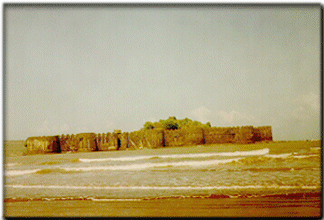 With the fall of Bahmani kingdom and the assassination of Nizamul-Mulk, his
son Malik Ahmed became supreme ruler in 1489 and founded Nizam Shahi in Ahmed Nagar with the
substantial help of the Habshees. In 1491-92 Malik Ahmed captured North Konkan and made Danda
Rajpuri its head quarters and appointed governor there.
After His death in 1508, his son Burhan Nizam Shah was enthroned. During his reign, two Shiah
Thanedars Mirza Ali and Kalbe Ali were sent there from Ahmed Nagar and they erected a Mausoleum
named Panjatan on the island west of Rajpuri. At that time Rajpuri was inhabited By Kolis who
were apprised by robbers. So they migrated to the island settled there and constructed buildings.
Ram Patil, the chief of these Kolis and hostile to the Thanedar, disallowed his entry. On the
island and disobeyed his orders Nizam Shah sent Peer Mohammed Khan with army and fleet to
Rajpuri. He subdued him with the gifts of money and wine.
With the fall of Bahmani kingdom and the assassination of Nizamul-Mulk, his
son Malik Ahmed became supreme ruler in 1489 and founded Nizam Shahi in Ahmed Nagar with the
substantial help of the Habshees. In 1491-92 Malik Ahmed captured North Konkan and made Danda
Rajpuri its head quarters and appointed governor there.
After His death in 1508, his son Burhan Nizam Shah was enthroned. During his reign, two Shiah
Thanedars Mirza Ali and Kalbe Ali were sent there from Ahmed Nagar and they erected a Mausoleum
named Panjatan on the island west of Rajpuri. At that time Rajpuri was inhabited By Kolis who
were apprised by robbers. So they migrated to the island settled there and constructed buildings.
Ram Patil, the chief of these Kolis and hostile to the Thanedar, disallowed his entry. On the
island and disobeyed his orders Nizam Shah sent Peer Mohammed Khan with army and fleet to
Rajpuri. He subdued him with the gifts of money and wine.
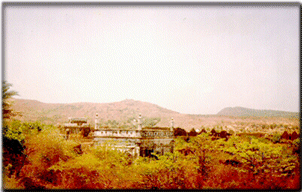 But later Ram Patil again rebelled. Then he, on the order of Nizam Shah, killed him in 1522,and
captured the island completely. After the death of Peer Mohammed Khan, Nizam Shah appointed
Burhan as Thanedar, who started building forts on the island in 1567 on the King's orders. The
meager income of Rajpuri province was supplemented by the income of Chool province and the
construction of fort was completed in 1571. It was named "Qilla-e-Jazjeerah-e- Mahroosa".
But later Ram Patil again rebelled. Then he, on the order of Nizam Shah, killed him in 1522,and
captured the island completely. After the death of Peer Mohammed Khan, Nizam Shah appointed
Burhan as Thanedar, who started building forts on the island in 1567 on the King's orders. The
meager income of Rajpuri province was supplemented by the income of Chool province and the
construction of fort was completed in 1571. It was named "Qilla-e-Jazjeerah-e- Mahroosa".
In 1612, Murtuza Nizam shah appointed Ibrahim khan as Thanedar who governed till
1618. In 1917 Malik Amber, the minister of Nizam Shah sent Siddi Amber Sahnak to Janjira.
He administered the state skillfully. Pleased with this, the king awarded him the state between
the creeks of Nagothana and Bankot and made him Admiral.
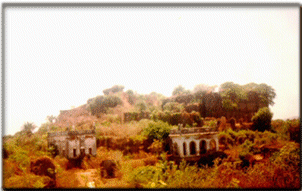 This Siddi Amber Sahnak is the founder of the state of Jazeera (Janjira) and the ancestor of
Nawabs of Janjira. It was governed by Siddi Suroor Khan between 1618 and 1620, when Siddi Yaqut,
also called Yaqut Shahejali, came to power in Rajpuri and reigned till 1921. He, on the fall of
Nizam Shahi founded a kingdom in Konkan. Siddi Yaqut had his mentor Sayyed Ali Nazeer with him.
In 1621, Nizam shah sent Siddi Amber again to Janjira with the gift of Danda Rajpuri and an
emblem. This made Siddi Amber a sovereign ruler and Thanedars ceased to be appointed by Nizam
Shahi. Sahnak was a gift of estate which was not taken back. Siddi Amber now became famous on
Siddi Amber Sahnak and started a rule of Nawabs of Janjira and ruled till 1642.
This Siddi Amber Sahnak is the founder of the state of Jazeera (Janjira) and the ancestor of
Nawabs of Janjira. It was governed by Siddi Suroor Khan between 1618 and 1620, when Siddi Yaqut,
also called Yaqut Shahejali, came to power in Rajpuri and reigned till 1921. He, on the fall of
Nizam Shahi founded a kingdom in Konkan. Siddi Yaqut had his mentor Sayyed Ali Nazeer with him.
In 1621, Nizam shah sent Siddi Amber again to Janjira with the gift of Danda Rajpuri and an
emblem. This made Siddi Amber a sovereign ruler and Thanedars ceased to be appointed by Nizam
Shahi. Sahnak was a gift of estate which was not taken back. Siddi Amber now became famous on
Siddi Amber Sahnak and started a rule of Nawabs of Janjira and ruled till 1642.
 Due to the fort of island and the inhabitation of Habshees, the state was known as State of
Habshaan Island, which was inscribed on the state seal the words of Al-mulka-Lillah, the
favorite state of Hazrate-Panjatan, and was also called the state of Panjatan.
When Siddi Qasim alias Siddi Yaqut Khan (1694 till 1706) started constructing another security
wall of the fort in 1701, Habshees had in their possession following 22 forts: Oochitgarh,
Goulkot, Mandangarh, Pratapgarh, Fateh Durg, Yashwantgarh, Ghosala, Talegarh, Sorgarh, Anjanvel,
Pradurg (Kasa), Victoriagarh (Bankot), VijayDurg, Mandgarh, Kondane, Raigarh, Anderi, Katwagarh,
Muktagarh, Khopgarh, Bairwadi, Janjira (State). Siddi Yakut khan ordered every Subedar to pay
for the expenses of one Burj (Pillar) each, and build for him a palace in Rajpuri and a dome in
Khokhri. After his death, Siddi Suroor Khan (1706 to 1732) re-started the construction of the
fort in 1706 and completed the outer security wall in 1728. The fort had the following 22 Burjs
namely: Halmukh, Arbah, Bahadur Shah, Yaqut khani, Saroli, Alwi, Sarja, Sardari, Khundari,
Pagar, Panel, Kafoor, Kastoori, Haidari, Ghamami and Talimkhana, Nagina, Murtuza, Khasgat,
Omani, Modikhana, Bhonda.
Due to the fort of island and the inhabitation of Habshees, the state was known as State of
Habshaan Island, which was inscribed on the state seal the words of Al-mulka-Lillah, the
favorite state of Hazrate-Panjatan, and was also called the state of Panjatan.
When Siddi Qasim alias Siddi Yaqut Khan (1694 till 1706) started constructing another security
wall of the fort in 1701, Habshees had in their possession following 22 forts: Oochitgarh,
Goulkot, Mandangarh, Pratapgarh, Fateh Durg, Yashwantgarh, Ghosala, Talegarh, Sorgarh, Anjanvel,
Pradurg (Kasa), Victoriagarh (Bankot), VijayDurg, Mandgarh, Kondane, Raigarh, Anderi, Katwagarh,
Muktagarh, Khopgarh, Bairwadi, Janjira (State). Siddi Yakut khan ordered every Subedar to pay
for the expenses of one Burj (Pillar) each, and build for him a palace in Rajpuri and a dome in
Khokhri. After his death, Siddi Suroor Khan (1706 to 1732) re-started the construction of the
fort in 1706 and completed the outer security wall in 1728. The fort had the following 22 Burjs
namely: Halmukh, Arbah, Bahadur Shah, Yaqut khani, Saroli, Alwi, Sarja, Sardari, Khundari,
Pagar, Panel, Kafoor, Kastoori, Haidari, Ghamami and Talimkhana, Nagina, Murtuza, Khasgat,
Omani, Modikhana, Bhonda.
Besides, the fort has 2 Burjs inside it, one is Gagan burj (Pillar) and the other is Khooni
burj in the middle. All the burjs (Pillars) are also told to be 19.
 Two burjs (Pillar) being together were probably counted as one. Suroor Khan built for him a dome
at Khokhri and a Jama Masjid (Mosque) at Rajpuri. Evidently the fort was not constructed at a
time, but various rulers made extensions and additions. Under Nizam Shahi rule (1567-1571) the
fort and its inside security wall were constructed. During Nawab's rule (1701-1728) the present
burj and security wall was built. After this different parts were renovated over a long period
of 28 years. Some stone plates have been fixed in the fort showing the names of the builders and
dates. One such plate fixed on the right of the wall of two burjs of the fortgate the following
verses are inscribed (engraved) showing the date of construction of Halmukh Burj.
Two burjs (Pillar) being together were probably counted as one. Suroor Khan built for him a dome
at Khokhri and a Jama Masjid (Mosque) at Rajpuri. Evidently the fort was not constructed at a
time, but various rulers made extensions and additions. Under Nizam Shahi rule (1567-1571) the
fort and its inside security wall were constructed. During Nawab's rule (1701-1728) the present
burj and security wall was built. After this different parts were renovated over a long period
of 28 years. Some stone plates have been fixed in the fort showing the names of the builders and
dates. One such plate fixed on the right of the wall of two burjs of the fortgate the following
verses are inscribed (engraved) showing the date of construction of Halmukh Burj.
"Ya Illahi Fazletu shud bar nabi khairul anam Barkate Khatam nabi Siddi Suroor, bashad madam
Nek mamash dar jahan bakht awali bashad zahoor. Hardo Halmukh burj ha Kardah bina Siddi Suroor,
Ba Kamale-aqle Tu jazeera karda noor. an binae-burj ra tareekh gasht az zahoor"
(The year 1111 Hijri)
The peculiar quality of construction of the fort wall is that the material used between two
stones is intact even today and bulged outside though the walls have been eroded due to the
billows of sea. 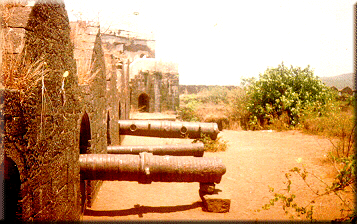 At the time of tide when water is ebbed, the rocks on which the fort is built are seen crystal
clear and the black tall security wall along with various burjs 50 feet high is seen. The gate
on the east built between the two burjs is 80 feet tall. There are stairs built from the fort
gate going down to the water. Above the gate on the burjs and security wall cannons are
installed. Some of the cannons are made in Sweden, Spain, Holland and France. The cannon named
as "Kalal Bangri" and made in India is 18 feet long, the longest. Besides the famous buildings
of the fort including "Nawab Ka Mahal, Siddi Suroor Ki Haveli, Topkhana, Baroodkhana,
Tahkhana". Jama masjid Naugazi Toshkhana, there were two vast tanks which where the fort was
inhabitated, there was no space left. It was thickly populated. There were hundreds of tall
homes annexed to one another like the steep hills. The fort and its colony on the island was
located at a height of 200 feet from the sea level and was called Chaukhandi.
At the time of tide when water is ebbed, the rocks on which the fort is built are seen crystal
clear and the black tall security wall along with various burjs 50 feet high is seen. The gate
on the east built between the two burjs is 80 feet tall. There are stairs built from the fort
gate going down to the water. Above the gate on the burjs and security wall cannons are
installed. Some of the cannons are made in Sweden, Spain, Holland and France. The cannon named
as "Kalal Bangri" and made in India is 18 feet long, the longest. Besides the famous buildings
of the fort including "Nawab Ka Mahal, Siddi Suroor Ki Haveli, Topkhana, Baroodkhana,
Tahkhana". Jama masjid Naugazi Toshkhana, there were two vast tanks which where the fort was
inhabitated, there was no space left. It was thickly populated. There were hundreds of tall
homes annexed to one another like the steep hills. The fort and its colony on the island was
located at a height of 200 feet from the sea level and was called Chaukhandi.
The Janjira fort like the caves of Ajanta and Gol Gumbad of Bijapur is a historical monument and a mark of glory. One is wonderstruck to see its creative trend and craft manship. Maulana Abdush Shakoor Kokate, the late poet of the konkan had narrated these facts in his poem:
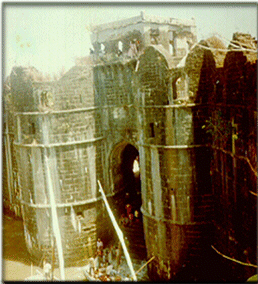 "If you are in search of a peerless creation, there is a masterpiece in the form of the
Janjira fort. It has been braving the dashing waves for the last four centuries, and still
stands at its place full of glory and splendor like a mountain".
"If you are in search of a peerless creation, there is a masterpiece in the form of the
Janjira fort. It has been braving the dashing waves for the last four centuries, and still
stands at its place full of glory and splendor like a mountain".
The regime of Habshi rulers was mostly full of clashes and conflicts with Marathas, Angras and Britishers. There were frequent attacks and seizures of the fort. Many attempts were made to conquer it during the reign of Shivaji and Sambhaji, but it never surrendered to anyone and remained unconquered till the last. Twenty-Four (24) Siddi Nawab's including a lady ruler reigned over the state of Janjira from 1621 to 1948. Last two rulers namely Nawab Sir Siddi Ahmed Khan (1833 to 1922) and Nawab Siddi Mohammed Khan (1933 to 1948) and their regime are noteworthy. They are known for the protection of their subjects, generosity, justice, and equal treatment to the people without discriminating on the basis of religion, caste or creed. They worked for the welfare of the people and enforced reforms. The official language was Marathi. Urdu and Persian were also taught alongwith Marathi. Teaching of English was also arranged. The head quarters of the state was at the Janjira Fort, which was later shifted to Murud by Nawab Sir Siddi Ahmed Khan, who made his permanent residence in the beautiful palace built on a pretty hill "Phool shehr" at the sea coast. Although official duties were traditionally performed in the fort itself where Subedar acted as the deputy of Nawab.
The vicinity of the fort is full of the marks of battles, old construction and historical
monuments. 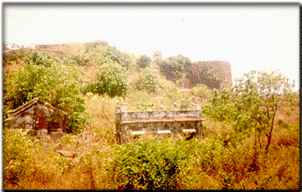 There are three Gumbads in "Khokhri" located between Danda and Rajpuri. These
Gumbads are built in the type of Gol Gumbads of Bijapur and consist of the graves of Nawabs
of Janjira, e.g. Siddi Khairiyat Khan (died in 1696), Siddi Yaqut Khan (died in 1706) and
Siddi Suroor Khan (died in 1734). They had built these Gumbads in their lifetime. The tomb
of Sayyed Ali Nazeer stands nearby, and also a small old mosque unattended. These historical
Gumbads remain un cared for and unprotected:
There are three Gumbads in "Khokhri" located between Danda and Rajpuri. These
Gumbads are built in the type of Gol Gumbads of Bijapur and consist of the graves of Nawabs
of Janjira, e.g. Siddi Khairiyat Khan (died in 1696), Siddi Yaqut Khan (died in 1706) and
Siddi Suroor Khan (died in 1734). They had built these Gumbads in their lifetime. The tomb
of Sayyed Ali Nazeer stands nearby, and also a small old mosque unattended. These historical
Gumbads remain un cared for and unprotected:
The spider is protecting the palace of Caesar and the owl is beating the drum (attending) at the dome of Afrasiyab (the great Persian warrior).
But the historical mosque built by Siddi Saroor Khan, lofty example of skill stands well attended even today by namazis (Prayer) located at an island facing Murud. At a distance of 6 miles from the fort Janjira, there stands Kasa fort, also called "Padmadurg" and built by sardar Daulat Khan, the then fleet commander of the Marathas during the attack on Janjira (1661 to 1670) by Shivaji. Sambhaji even tried to fill up the sea between Rajpuri and the Fort in order to capture the Janjira Fort. When water retreats after a tide, a row of stones is visible and that is the reminiscent of this attempt.

When India became free nearly 500 princely states were abolished and merged in the Indian Union. In 1948 the state of Janjira too was merged in District Raigad and the period of Nawabs ended with the start of Democracy. After merger the population inside the fort was adversely affected. During the Nawabs rule they got state patronage. Many people were employed in the court and got annual sanad (cash and grains for remuneration) and money for their subsistence. After merger the people of the fort lost their livelihood, and were forced to leave the fort. They dismantled their houses, sold away their belongings and migrated to other places. Thus the fort was depopulated. The Royal proclamations, majestic grandeur, court magnificence, activities of the inhabitants all are gone. The delicate tunes of trumpets notes of flutes and beats of drums. Lofty buildings and sky-tall palaces have fallen to the ground and the memorials are in the ruins. But the Janjira fort, an embodiment of faith and determination is still standing these gracefully, hiding in its bosom the wounds of negligence of time and narrating the old story of rise and fall and has become focus of attention of the tourists and travelers.